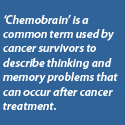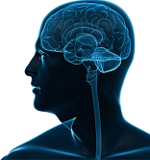Exercise as Key Component of Treatment for “Chemobrain”
Although the primary focus of this blog is on “traumatic” brain injury, the literature increasingly demonstrates that the physiological causes of cognitive impairment overlap between a range of conditions having neurodegenerative consequences, including TBI, PTSD, Alzheimer’s disease and “Chemobrain”. (Chronic inflammation appears to be one of the common variables, as discussed in prior posts.)
 In recent years we have seen an acceleration in research concerning TBI, some of it fueled by funding from the military and from professional sports. Less information is known about a common and often debilitating consequence of cancer treatment (experienced by up to 60% of cancer patients following treatment) often referred to as “Chemobrain.” An increasing body of literature documents decline in subjective and objective cognitive functioning as well as structural and neurophysiological alterations in the central nervous system after medical treatment for cancer. The most common declines in function are found in executive function, attention, memory and learning. The underlying causes of these declines, as well as the most promising interventions, are discussed in a recent review article published by Zimmer, et al, in BioMed Research International.
In recent years we have seen an acceleration in research concerning TBI, some of it fueled by funding from the military and from professional sports. Less information is known about a common and often debilitating consequence of cancer treatment (experienced by up to 60% of cancer patients following treatment) often referred to as “Chemobrain.” An increasing body of literature documents decline in subjective and objective cognitive functioning as well as structural and neurophysiological alterations in the central nervous system after medical treatment for cancer. The most common declines in function are found in executive function, attention, memory and learning. The underlying causes of these declines, as well as the most promising interventions, are discussed in a recent review article published by Zimmer, et al, in BioMed Research International.
Noting the limitations in the literature and need for more study, the authors did find that exercise is a promising method to counteract the impact of Chemobrain. The support for this conclusion overlaps with what has been found in studies reported in this blog about the effectiveness of controlled exercise treatment for TBI. As with TBI patients, cancer patients frequently demonstrate markers of chronic inflammation (such as Interleukin-1 and TNF-alpha) which are counteracted by exercise. The review also reports on studies showing that aerobic exercise leads to increased expression of neurotrophic and neuroprotective factors, such as the brain-derived neurotrophic factor, the vascular endothelial growth factor, and the insulin-like growth factor. Some studies showed that exercise induced neurogenesis was actually accompanied by increased volume in the hippocampus as well as increased functioning of hippocampus dependent cognitive abilities. The authors also note that exercise is associated with the secretion of specific neurotransmitters such as dopamine, which plays an important role in prefrontal regulation.
Although the primary focus of the review and the literature is aerobic exercise, the authors also note evidence of the positive effects of “Asian-related movement interventions” (such as Yoga) which improve mood, motivation and mindfulness and also reduce systemic inflammation. A common effect of both forms of exercise, the authors note, is improved sleep, which is generally associated with increased cognitive performance.
One caution noted by the authors is that some recent research suggests that exercise alone might not be sufficient to induce long-lasting, functional neurogenesis, unless combined with a cognitive training program.
We still have a great deal to learn about the cause of Chemobrain and the most effective interventions, but it appears that exercise and cognitive training are key components.

